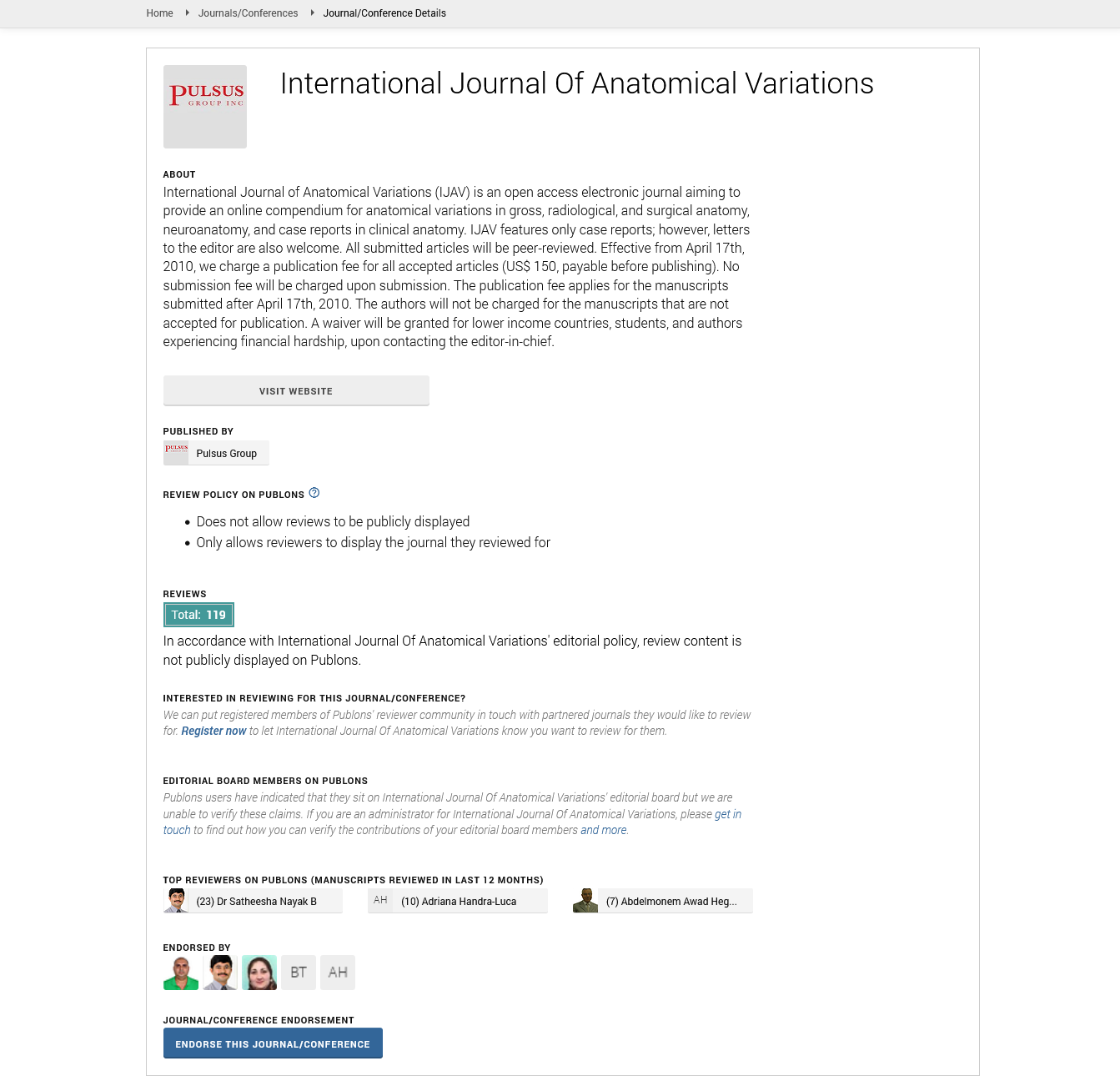Rare Variations of the Head and Neck Lymphatic System: Implications for Cancer Diagnosis and Treatment
Received: 02-Dec-2024, Manuscript No. ijav-24-7358; Editor assigned: 04-Dec-2024, Pre QC No. ijav-24-7358 (PQ); Reviewed: 18-Dec-2024 QC No. ijav-24-7358; Revised: 26-Dec-2024, Manuscript No. ijav-24-7358 (R); Published: 31-Dec-2024, DOI: 10.37532/1308-4038.17(12).465
Citation: Wang Z. Rare Variations of the Head and Neck Lymphatic System Implications for Cancer Diagnosis and Treatment. Int J Anat Var. 2024;17(12): 699-700.
This open-access article is distributed under the terms of the Creative Commons Attribution Non-Commercial License (CC BY-NC) (http://creativecommons.org/licenses/by-nc/4.0/), which permits reuse, distribution and reproduction of the article, provided that the original work is properly cited and the reuse is restricted to noncommercial purposes. For commercial reuse, contact reprints@pulsus.com
Abstract
The lymphatic system plays a crucial role in maintaining fluid homeostasis and immune surveillance, particularly in the head and neck region. Its network of vessels, nodes, and associated structures serves as a primary route for the metastasis of head and neck cancers. Although significant attention has been given to the standard anatomical features of the lymphatic system, rare variations in the lymphatic architecture of the head and neck region have been less thoroughly explored. This article investigates the rare anatomical and functional variations in the head and neck lymphatic system, their potential implications for cancer diagnosis, staging, and treatment, and how these anomalies could influence clinical practice. These variations, ranging from abnormal lymphatic drainage patterns to the presence of ectopic lymph nodes, necessitate an updated understanding of the lymphatic system in the context of head and neck oncology
INTRODUCTION
The head and neck lymphatic system, with its complex network of lymphatic vessels and nodes, is critical in regulating immune responses and maintaining fluid balance. The system plays a key role in the metastatic spread of cancers in this region, including those of the oral cavity, pharynx, larynx, and salivary glands. The anatomical characteristics of the lymphatic vessels, including their drainage patterns and regional node involvement, have been well-documented in the scientific literature. However, rare variations of the lymphatic system are often overlooked and may have significant implications for cancer diagnosis, staging, and management. These rare variations can complicate both the clinical assessment of cancer metastasis and surgical interventions, which are vital for patient prognosis [1].
ANATOMY OF THE LYMPHATIC SYSTEM IN THE HEAD AND NECK
The lymphatic system in the head and neck comprises a complex network of vessels and nodes responsible for draining lymphatic fluid from tissues in the region. Lymphatic vessels are present in virtually all tissues, with dense concentrations in areas such as the mucous membranes of the oropharynx, nasopharynx, and larynx. The primary nodes of the head and neck are classified into various levels, including level I (submental and submandibular), level II (upper jugular), level III (middle jugular), level IV (lower jugular), and level V (posterior triangle). In addition to these traditional groupings, there are deep cervical nodes that drain more distal regions [2]. The head and neck lymphatic system is responsible for draining lymph from the scalp, face, and neck, as well as from the respiratory and digestive tracts. Several factors influence the drainage patterns, including the location of tumors and the presence of congenital anomalies. These factors can lead to variations in the typical lymphatic drainage pathways, which may complicate clinical evaluations and treatments for head and neck cancers [3].
RARE VARIATIONS IN THE LYMPHATIC SYSTEM OF THE HEAD AND NECK
Rare variations in the lymphatic system of the head and neck can manifest in several forms, including ectopic lymph nodes, anomalous lymphatic vessels, and abnormal drainage patterns. These variations can occur due to congenital anomalies or secondary changes resulting from diseases such as infections or tumors.
Ectopic Lymph Nodes
Ectopic lymph nodes are lymph nodes that are located outside of the typical drainage regions. These nodes are not uncommon in the head and neck, though they are relatively rare. In some cases, ectopic lymph nodes may be found in unusual locations, such as the thyroid gland, the mediastinum, or within muscles of the neck. These nodes are often asymptomatic and may not be detected during routine clinical examinations. However, when detected in the context of head and neck cancer, they can complicate the accurate staging of the disease, as their presence may suggest that metastatic disease has spread beyond the expected regional nodes [4].
Abnormal Lymphatic Drainage
Abnormal lymphatic drainage patterns can occur due to various factors, including congenital malformations, inflammatory diseases, or the presence of a primary tumor. These anomalies may result in lymphatic fluid draining to unintended or unusual regions. For example, there have been reports of tumors in the head and neck region exhibiting drainage into the contralateral lymphatic system, which can mimic metastasis from a distant primary site [5]. Additionally, the presence of lymphatic vessels within unexpected areas of the head and neck, such as deep tissues or near the skull base, may result in the misinterpretation of lymphatic spread during cancer staging procedures.
Supernumerary Lymphatic Vessels
In some rare cases, supernumerary lymphatic vessels may form in the head and neck. These vessels are in addition to the normal lymphatic vessels and can arise as a result of developmental anomalies or as compensatory structures when the primary lymphatic drainage is obstructed. The presence of these vessels may be difficult to distinguish from other vascular structures during imaging procedures, posing challenges for surgeons and oncologists in accurately assessing the extent of disease spread [6].
IMPLICATIONS FOR CANCER DIAGNOSIS AND STAGING
The detection of rare lymphatic variations in head and neck cancer patients presents significant challenges for cancer diagnosis and staging. Lymphatic drainage plays a crucial role in the staging of cancers, particularly when determining the extent of metastatic spread. The presence of ectopic lymph nodes or abnormal drainage patterns can complicate the clinical assessment of regional metastasis, potentially leading to misdiagnosis or underestimation of disease extent. For instance, patients with ectopic lymph nodes may undergo unnecessary biopsies or treatments based on erroneous assumptions about the location of metastatic spread. Moreover, rare variations in the lymphatic system can affect imaging techniques such as positron emission tomography (PET) and computed tomography (CT) scans [7]. These imaging modalities rely on the accurate identification of lymphatic involvement and may fail to detect lymphatic variations that do not conform to standard patterns. This can lead to inaccuracies in tumor staging, which directly impacts treatment decisions, including whether to proceed with surgical lymph node dissection or radiation therapy [8].
IMPLICATIONS FOR CANCER TREATMENT
The presence of rare variations in the lymphatic system also has significant implications for treatment planning and patient management. Surgical removal of lymph nodes is a key component of the treatment for many head and neck cancers. Variations in lymphatic drainage can necessitate more extensive surgical procedures, as surgeons must account for anomalous drainage patterns to ensure that all relevant lymph nodes are removed [9]. Additionally, the identification of ectopic lymph nodes or supernumerary lymphatic vessels may alter the standard approach to neck dissection, as the surgeon must ensure that these structures are appropriately addressed to minimize the risk of recurrence. Radiotherapy also presents challenges in patients with rare lymphatic variations. The accurate targeting of affected lymph nodes is crucial for the effectiveness of radiation treatment and the presence of abnormal drainage or ectopic nodes can complicate this process. In some cases, traditional radiation fields may not encompass all areas at risk of metastatic involvement, potentially leading to incomplete treatment. Furthermore, patients with unusual lymphatic patterns may require more personalized or advanced treatments, such as intensity-modulated radiation therapy (IMRT) or robotic-assisted surgery, which can offer more precise targeting of affected areas [10].
CONCLUSION
Rare variations in the lymphatic system of the head and neck represent a significant challenge in the diagnosis and management of head and neck cancers. These anomalies, which include ectopic lymph nodes, abnormal drainage patterns, and supernumerary vessels, can complicate both the detection and staging of metastatic disease. Clinicians must be aware of these rare variations to avoid misdiagnosis and to improve treatment outcomes. Advances in imaging technology and surgical techniques offer new opportunities to address these challenges, providing more precise and personalized care for patients with head and neck cancer. As our understanding of these rare variations continues to grow, their implications for cancer diagnosis and treatment will become an increasingly important consideration in the field of oncology.
REFERENCES
- Szymczak M, Krupa P, Oszkinis G, Majchrzycki M. Gait pattern in patients with peripheral artery disease. BMC Geriatrics. 2018; 18:52.
- Albulescu D, Constantin C, Constantin C. Uterine artery emerging variants - angiographic aspects. Current Health Sciences Journal 2014; 40:214-216.
- Osher M, Semaan D, Osher D. The uterine arteries, anatomic variation and the implications pertaining to uterine artery embolization. J Vasc Interv Radiol 2014; 25:S143.
- Fontana F, Coppola A, Ferrario L. Internal Iliac Artery Embolization within EVAR Procedure: Safety, Feasibility, and Outcome. J Clin Med. 2022; 11(24):73-99.
- Nayak SB, Shetty P, Surendran S, Shetty SD. Duplication of Inferior Gluteal Artery and Course of Superior Gluteal Artery Through the Lumbosacral Trunk. OJHAS. 2017; 16.
- Park K-M, Yang S-S, Kim Y-W, Park KB, Park HS, et al. Clinical outcomes after internal iliac artery embolization prior to endovascular aortic aneurysm repair. Surg Today 2014; 44:472-477.
- Patel SD, Perera A, Law N, Mandumula S. A novel approach to the management of a ruptured Type II endoleak following endovascular repair of an internal iliac artery aneurysm. Br J Radiol. 2011; 84(1008):e240-2.
- Bleich AT, Rahn DD, Wieslander CK, Wai CY, Roshanravan SM, et al. Posterior division of the internal iliac artery: Anatomic variations and clinical applications. Am J Obstet Gynecol. 2007; 197:658.e651-658.e655.
- Chase J. Variation in the Branching Pattern of the Internal Iliac Artery. In: University of North Texas Health Science Center. Fort Worth. 2016: 1-33.
- Rayt HS, Bown MJ, Lambert KV. Buttock claudication and erectile dysfunction after internal iliac artery embolization in patients prior to endovascular aortic aneurysm repair. Cardiovasc Intervent Radiol. 2008; 31(4):728-34.
Indexed at, Google Scholar, Crossref
Indexed at, Google Scholar, Crossref
Indexed at, Google Scholar, Crossref
Indexed at, Google Scholar, Crossref
Indexed at, Google Scholar, Crossref
Indexed at, Google Scholar, Crossref
Indexed at, Google Scholar, Crossref






